JAXA Astronaut Activity Report, October, 2012
Last Updated: December 21, 2012
This is JAXA's Japanese astronaut primary activity report for October, 2012.
20th anniversary symposium since the FMTP/STS-47 mission in 1992

JAXA astronauts pose for a memorial photo (from left, astronauts Kanai, Noguchi, Mohri, Mukai, and Wakata) (Credit: JAXA)

Mohri speaks at the symposium (Credit: JAXA)
On October 11 and 14, JAXA held a symposium celebrating its 20th anniversary since astronaut Mamoru Mohri made the first space flight aboard the space shuttle by a Japanese during the FMPT/STS-47 mission in 1992.
The first day of the symposium on October 11 was held in the Tokyo Prince Hotel, based on the theme of "Japanese astronauts discuss the 20 years of progress and future prospects."
Part 1 started with a history of Japanese human space flight reviewed by a video. Subsequently, astronaut Mohri delivered a lecture on the 20 years of activities since the STS-47 mission and the target for the next 20 years. Through long years of experience, Mohri discussed his view on the purpose of human space flight, stating that Japan's human space activity should be one which helps resolve various issues with which human beings are confronted.
During Part 2, a panel discussion was held on the theme of "the 20 years of progress and expectations for the future, from the from the Japanese astronauts's perspective." For the panel, in addition to Mohri and JAXA astronauts Mukai, Wakata, Noguchi, and Kanai, Toyohiro Akiyama, a journalist and former TBS employee, who is the first Japanese to have traveled into space, Yuichi Takayanagi, Director of the Tamarokuto Science Center, and Takashi Tachibana, a journalist, were invited; and Tetsuya Muroyama, a commentator from NHK (Japan Broadcasting Corporation), moderated the panel. Mr. Tachibana raised issues including "considering the enormous amount of money spent to date, the activity doesn't yield a fair return" and "unlike the U.S., Japan lacks the cultural basis of living with a human suffering accident and overcoming it to move forward." The discussion even expanded to a theme "should Japan create a human spacecraft," and saw the panelists engage in heated debate from their individual perspectives.

Panel discussion (Credit: JAXA)

Mohri gives his opinion at the panel discussion (Credit: JAXA)
The second day of the symposium on October 14 was held at the Shinagawa Intercity Hall on the theme of on-site human space development. Kanai participated in both Parts 1 and 2 on that day.

Kanai discusses his experience during the astronaut candidate selection.
In Part 1, Kanai commentated each lecture by those in charge of astronaut candidate selection, the training of astronauts, and the operations of the Japanese Experiment Module "Kibo." Kanai also answered questions raised from the audience, including the on-site atmosphere he experienced.
While explaining experiments performed on Kibo, Kanai reminisced about his time facing patients as a hospital doctor. He discussed that "Kibo's experiments may contribute to help patients who have not yet been saved. Though I'm not now in a position to see patients, I'm proud of contributing to the development of new medicine and also excited to be able to save more patients." Even though his position has changed from a doctor to that of an astronaut, his unchanged wish to save patients was emphasized.
During the panel discussion in Part 2, Kanai introduced the episode when he visited NASA for training and realized that NASA has enhanced trust in JAXA, as well as in Japanese space development technology. He also introduced the actual human space development atmosphere, including his struggles during training.
At the end of the panel, Kanai discussed his view on the meaning of promoting space development, by stating that "accumulating science technology through space development will definitely become a power for Japan in future."
Astronaut Yui was assigned to the ISS long-duration mission
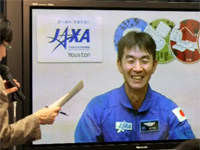
Yui at the press conference (Credit: JAXA)
On October 5, Astronaut Yui was assigned as one of the long-duration crew members for the ISS Expedition 44/45.
Yui will commence his stay on the ISS for about six months from around June 2015, aboard the Soyuz spacecraft for both the launch and return.
Following the decision of the assignment, Yui held a press conference at the JAXA Houston Office where he is now, connecting the JAXA Tokyo Office.
At the beginning of the press conference, Yui stated his present feelings, discussed his future aspirations, and appreciated all the support received.
During the interview with news media, Yui quoted "a star of the middle-aged", the words he said at the press conference when selected as one of the astronaut candidates. "I'm still at the sixth-magnitude level, but will strive to accomplish this mission and hopefully become a gleaming, first-magnitude middle-aged star." Then he looked back at the time when he first became an astronaut candidate to the present. "At first, to be an astronaut seemed a distant goal, but I made it with continuous efforts." He continues, "it still seems a far distant goal to work on the same level as seniors, but if I overcome what I have to do, step by step, I believe I can approach their level," Yui explained his attitude toward the long duration mission.
Astronaut Onishi's training for a Robotics Specialist
Continuing from the operation training for the Mobile Servicing System (MSS) at the Canadian Space Agency (CSA) in September, astronaut Onishi started his training to become a System Specialist at the NASA Johnson Space Center in Houston, U.S.
Through simulation operations necessary in orbit, the training aims to enhance the operation technique acquired in the previous training to a practical level. The curriculum lasts two months; training to support Extravehicular Activities (EVA) using the Space Station Remote Manipulator System (SSRMS) in the first one month.
Onishi learned operations to carry EVA crew on the edge of the SSRMS and large equipment. In situations where fine position control is required, he learned the ropes according to spacewalker's requests as well as communication under such circumstances.
In addition, Onishi received training in preparation for emergency cases in the event of a leak from a spacewalker's Extravehicular Mobility Unit (EMU), repeatedly practicing procedures to move the EVA member to a safe place.
Onishi is scheduled to continue his training to qualify as an SSRMS Specialist.
Astronauts Mukai and Noguchi participated in the International Astronautical Congress (IAC)

Mukai (center) and Noguchi (leftmost) at the reception (Credit: JAXA)
From October 1 to 5, astronauts Mukai and Noguchi participated in the 63rd International Astronautical Congress (IAC) held in Napoli, Italy.
Mukai appeared at the panel discussion entitled "Benefits to the Earth from Space Agencies Around the World" as a panelist while Noguchi spoke in one of the keynote lectures entitled "Soyuz, Shuttle, ISS - Astronauts' Perspectives." They also visited a venue for IAC student sessions and communicated with the representative students of each country.
For the IAC 2012, executives from each space agency, astronauts, and researchers gathered and interacted alongside an aerospace industry exhibition, sharing active opinions.
During the plenary session held on the last day, the great news was announced that Kiyoshi Higuchi, JAXA Vice President, had been selected to become the next president of the International Astronautical Federation (IAF).
Astronauts Wakata and Kanai held a lecture during the open house event at the TKSC
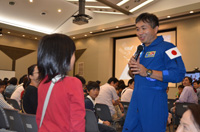
Wakata approached the child to answer a question (Credit: JAXA)
Astronauts Wakata and Kanai appeared at some of the TKSC open house events on October 13.
During a session that allows the opportunity to talk with Wakata, Wakata introduced his ISS long-duration mission and answered many questions coming from the audience.
Wakata and Kanai joined in a dialogue entitled "Mieruka (visualization) of space development" with a general public audience to discuss which trajectory future human space development should follow, its purposes and the required or expected missions. In addition, they also held a talk show to discuss why they challenged space, before then communicating with the audience.
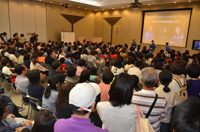
A talk-show session (Credit: JAXA)

Mieruka of space development dialogue (Credit: JAXA)
Kanai participated in the space experiment show, performed experiments with participating children and walked around the facility and took memorial photographs with the visitors.
Astronaut Kanai participated in the "Space Talk"

Space Talk session (Credit: JAXA)
On October 24, as one of the events held to commemorate the 20th anniversary of Japan-U.S. human space flight cooperation in Washington D.C., astronaut Kanai participated in the "Space Talk" event and discussed the history of Japanese human space flight development and future prospects. He enjoyed exchanges with Japanese and American audiences.
New Astronauts at the Front-Line

First of all, I would like to thank you all for your support since JAXA announced that I had been selected as a crew member for the 44th/45th Expedition Mission for a long-duration stay aboard. I wonder whether some might feel like I had reached this stage prematurely, since I only started this diary several months ago, in April this year, when preparation for the NASA Extreme Environment Mission Operations (NEEMO) training got underway. My real challenge, however, started about 4 and half years previously, when I filled in the application form for an astronaut prepared by my wife. Alternatively, it might have started at the age of 24, when I watched a film titled "The Right Stuff", or perhaps when I was a 3rd-grade elementary school student, with an emerging interest in space…more than 30 years since then. Reviewing my long journey brings home my quite manifold experience to me and my efforts to date help me today.
Have you ever chosen your work at your office or study at school with your own preconceived ideas? "This will not be useful after all", "I won't study hard in this subject, which does not set tests anyhow", "There's no benefit to doing this." I confess that I used to select everything with my own preferences and think like this. Of course it is important to prioritize what to do because we cannot do everything at once, but we have to remember that discarding something for an easier life often brings us regret in future. As I said on Twitter, many of my friends told me who studied hard in math, physics, and astronomy: What you are studying will not serve you because you will not use it."
Physics and mathematics are, however, actually essential to the work of pilots, who need to know the limits of airplanes' abilities and their components while the acquired astronomical knowledge considerably helps me in my work as an astronaut.
Conversely, regarding what I excluded such as German, Japanese, art, and calligraphy, I often regret and feel that I should have studied harder. For example, I felt sorry for German people when I trained in Germany because I could not speak their language. Sometimes I feel discouraged when I find myself at a loss to choose appropriate words to convey the importance of space development and splendor of space, or lacking in artistic taste to introduce the beauty of space. Conveying aspects of space understandably to people and what moved me in missions is one of my essential works as an astronaut. Now I realize the importance of knowledge in fields which I used to consider as useless. Therefore, I would like the younger generation, who tend to make choices based on little experience, to be fully circumspect when selecting to avoid regrets.
Right from the start, we should note that no useless knowledge exists in this world! What you may consider useless is actually an object you are not utilizing properly: once you start capitalizing on your knowledge, you will surely see it applied to a wealth of things. The idea that no human is born evil, but their surroundings cause crimes, which I learned in criminal psychology, and knowledge about human actions taken under an extreme environment, which I acquired through books on military psychology, are very helpful when I analyze myself or work as a leader under the harsh environment. I believe that the key is an attitude to work at everything with interest and a strong will to exploit personal experience and knowledge obtained through the same in future.
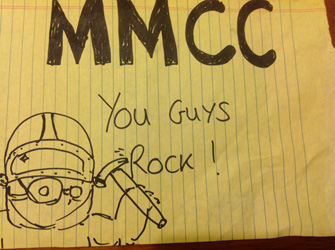
This is a picture I drew abruptly, when asked by one of the staff in the NEEMO training when they sent a message to the on-ground controllers! (LOL) I should have studied art more earnestly when young...

This photo is when I was at the interview. I wish I could discuss my own feelings and the significance of space development with beautiful and understandable Japanese, which seems to require time and effort. Feeling that I should have studied Japanese harder..., but I believe it is not too late. I promise you I will continue to learn! Currently I aim to reach the same level as Messrs. Onishi and Kanai, who go ahead of me.
* Photos are courtesy of JAXA.

Currently undergoing training on the robotic arm of the International Space Station (ISS) (Space Station Remote Manipulator System: SSRMS), I would like to introduce the SSRMS twice, over these two months: This month I will briefly describe the nature of the robotic arm, followed next month by concrete details about the type of training astronauts face.
Launched in 2001 after being constructed in Canada, the robotic arm for the ISS (referred to as 'the robotic arm' below) has enabled wide-ranging activities, including the assembly of the ISS, transfer and removal of experimental facilities, and capture operations of H-II transfer vehicles such as KOUNOTORI.
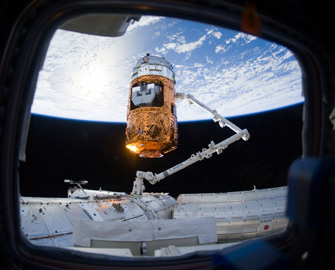
Photo of the Robotic Arm capturing KOUNOTORI 2
Taking a familiar example, the robotic arm resembles stationery, a pair of compasses. Measuring about 17 m from side to side when fully extended, it is still much smaller than the ISS, with a total length exceeding 100 m. From the located point, the arm cannot reach straight to the edge of the ISS.
To meet the need for all-round accessibility for its work, the robotic arm includes several sets of equipment.
The first is a Mobile Transporter (MT), on which the robotic arm can move along and enabling the whole robotic arm to move freely on the handrail installed on the main ISS structure.
The second device is the inchworm-like movement of the robotic arm itself on the ISS. 'Inchworm' might sound old-fashioned and incomprehensible, so let me explain in more detail.
The robotic arm itself is machinery requiring moving gear such as electricity and communication circuits. An electrical motor activates the joints of the robotic arm, while the communication circuit controls its movement. Something like sockets supplying electricity and communication (in technical terms, referred to as Power and Data Grapple Fixture, PDGF) are attached to each ISS module.
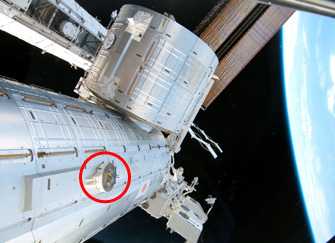
The red circle on the photo indicates a PDGF attached to the Japanese Experiment Module "Kibo".
Let's return to the previous example of a pair of compasses. Compasses receive electricity and communication from its leg attached to socket A.
When expanded, another leg captures socket B elsewhere, at a point which also provides electricity and communication, which means that compasses are constantly supplied with both. Using socket B as a fulcrum, the leg detached from socket A moves and captures socket C elsewhere.
It is difficult to explain in words alone, isn't it? :)
Can you imagine the robotic arm traveling along with two legs moving in turns??
Now I discussed how the robotic arm travels to the workplace - the next step is how it works.
The key role of the robotic arm, literally the mechanical arm, is to carry heavy or large loads. Launched onboard the Space Shuttle, the Japanese Experiment Module "Kibo" was successfully installed on board the ISS by this robotic arm.
Since 'carrying things' requires 'capturing things' in advance, the tips of both of the robotic arm (though my example of compasses uses the term 'leg', the word 'arm' is more appropriate for the robotic arm) are designed to capture things. As mentioned above, one arm moves to capture the object while the other captures a socket.
So let's consider the case where humans take things on the desk.
Firstly, when examining an object with our own eyes, we judge its shape and estimate its distance. Secondly, our brains instantly judge how we should move the joints from shoulder to fingertips to capture the object. Finally, we can capture it by actually moving our joints by using muscles.
The robotic arm works in the same way. It judges the distance between the arm and the object, referring to the images from cameras installed onboard the ISS and on the robotic arm itself and subsequently moves freely within the three-dimensional space with its unique 7 joints. Just like human arms, the arm's joints are deployed at points equivalent to human shoulders, elbows, and wrists and a combination of each joint movement enables the robotic arm to move its arms to the desired points.
Joint movements are controlled by a computer (brain) and driven by motors (muscles) using electricity. As it is humans' work to command computers, the brain, this is a task for astronauts in space or engineers on the ground.
This is basically the function of the robotic arm - I wonder if my general explanation helps enough? If you have additional questions or require a more detailed explanation, I would be glad to answer as far as possible in the next courier if you send me questions through our Question Form.
I will discuss astronauts' training with the robotic arm next month.
* Credit: JAXA/NASA

I was delighted at the news that Astronaut Hoshide had conducted the 3rd Extra-Vehicular Activity (EVA) with his partner Astronaut Williams, bringing great success just before his return to Earth. One of the most crucial parts of the solar panel, which provides electric power with the ISS, had been damaged, which led to all the ground-based controllers, engineers, EVA staff, project managers as well as astronauts supporting their activities on the ground holding their breath to watch the two astronauts repair in space. After the EVA was successfully completed, those involved at the Johnson Space Center in Houston got so excited that some merrymaking ensued. Unlike the 1st and 2nd EVAs, elaborately planned with full training for the astronauts on the ground, the 3rd EVA was a sudden event in response to unexpected damage. I believe that the accumulated experience and training of the two astronauts were key to the success of its safe and secure implementation.
This month, I would like to introduce extra-vehicular activities to you. To install and operate new rooms such as "Kibo" (referred to as a module), launched aboard the Space Shuttle, onboard the ISS and install new components and experimental equipment outside the ISS during its assembly, or replace and repair damaged components like the 3rd EVA, astronauts work in space suits outside the ISS, which is known as "Extra-Vehicular Activity (EVA)."
To me, Extra-Vehicular Activity seems like a difficult term. In English it is referred to as "EVA", its abbreviation. More generally it often means a "space walk" in English, whereas in Japanese, the term is translated as "floating in space." Either "space walk" or "floating in space"
ives me an image of floating in a weightless space and seems elegant, but I wonder how it really is in space. Lacking experience of space exploration and extra-vehicular activity, of course, I look forward to ask Astronaut Hoshide about this, if possible.
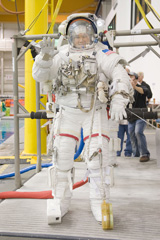
However, based on the EVA training on the ground, I am afraid to give you my honest impression that the actual EVA is very harsh work, and far from elegant exercise. "On the ground" means "on Earth, not in space." The training takes place on Earth with gravity under simulated weightlessness, exactly, using buoyancy in water. The full-size model of the ISS (referred to as a mock-up) is immersed under water for astronaut training in the Neutral Buoyancy Lab (NBL), a gigantic pool 100m long and over 10m deep, at the Johnson Space Center. Working in pairs, astronauts repeatedly undergo preparation training for various activities onboard the ISS.
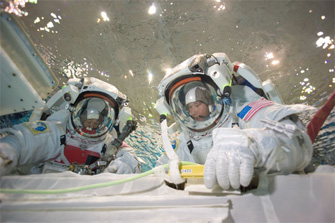
As in the actual activities in space, astronauts cannot freely take rest back in the ISS at lunchtime, for example. Once started, the activity continues for about 6 hours non-stop. Though they can gradually quench their thirst with a straw attached to a water bag installed in the space suits, astronauts cannot eat until the activity is completed. (This means they must take sufficient breakfast on the morning of the training.) It is also to be noted that they participate in the training (and also space activities) wearing diapers because they are not allowed even to go to the bathroom during the work.
Actually in a space environment, the area around the space suit is a vacuum space. This obviously prevents humans from living like on Earth, obliging astronauts to maintain an artificial working environment enabling them to survive and work with their space suits filled with oxygen. The space suit has so many different functions that the suit itself resembles a small spacecraft, which I could discuss for hours. Above all, the key feature is a function for pressure: the pressure in the space suit is set 0.3-0.4 higher than the vacuum outside the suit. The same applies to pool training because air is constantly supplied to a space suit to maintain the inner pressure 0.3-0.4 higher than the water pressure outside the suit.
In other words, astronauts resemble fully inflated balloons (space suits). Working in air-inflated space suits involves stretching and bending of arms and grasping against the inner pressure. In EVA, astronauts move slowly along the handrails installed on the outer wall of the ISS, which exposes them to a considerable burden, despite looking so easy, as they repeatedly grasp the handrail for training to strengthen their grip.
The 6-hour EVA continues ceaselessly: attaching and detaching safety halters, taking out and returning various tools from the tool box, using screwdriver drills, installing, removing and carrying damaged equipment, etc. As each task requires astronauts to change their attitudes, bend and stretch their arms, and grip, the activity can be compared to 6-hours' muscle training.
Though high-spirited for a while after starting the EVA training, astronauts start getting exhausted and their grip weakens over time, meaning even simple work becomes difficult. Complicated and hard work sometimes becomes much more difficult for them because it requires fruitless trials and repeated work maintaining the same harsh posture for hours. As embarrassing as it is, honestly speaking, the more exhausted I feel, the worse my mood and the more irritated I often become during training, which exasperates me. Besides, during the activity, astronauts are required to constantly maintain radio traffic with their partner astronauts and supporting engineers (in training, instructors outside the pool), which sometimes leaves me lost for words and less capable of speaking correct English.
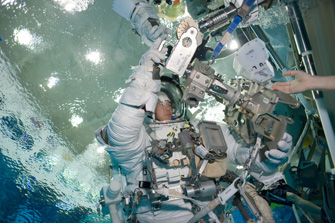
When immersed in the pool wearing a space suit for the first time as an astronaut candidate, I often felt frustrated because I was worn out after just the first 1 or 2 hours or could not complete the task within the training time. A few days before Astronaut Hoshide's 3rd EVA on the ISS, coincidentally, I also underwent EVA training working in a pair with Astronaut Furukawa. He overwhelmed me with his remorseless physical strength, accuracy to successfully complete any task, even at the first try, and continued attentiveness toward those around him, even during the latter half of the training. I often had training with experienced astronauts, including Astronaut Furukawa, and both Japanese and Americans, and in the early stages, I tended to think that the gaps in skills, strength, and experience between the experienced members and me, as a beginner, were inevitable.
Accumulated reflection after multiple training failures, however, is changing my idea recently: "self-assessment" might work as a key factor. Any human, however strong, tires after working for hours. The crucial point is how he/she performs his/her own duties while objectively assessing his own state. An astronaut doing hard work on his/her own without success might need to ask his/her partner for help. When exhausted and irritated, the astronaut needs to stop working for a while to calm down. When he/she tires increasingly in the latter half of the training, an astronaut should strive to speak more vigorously and care about partners, reflecting the need to maintain cheerfulness with jokes. Now I have come to think that accepting the reality that I am imperfect and choosing how to act at any time ultimately brings the best end result.
Though I might not be as good at handling activities as our experienced astronauts, it makes no sense if I were to overestimate my abilities, thus resulting in important tasks failing and damage to precious spare equipment to be installed on the ISS. I will strive hard to judge dispassionately what I can and cannot do at this time and determine the most effective way to achieve the objectives of the activities while responding to changing conditions. This activity, testing personal judgment and sharpness, teaches me every time, and is always of interest.
The interest in "extra-vehicular activities" is wide-ranging, and goes beyond just the content of the training. My previous job was health management of divers of the Maritime Self Defense Forces. Curiously, going out to space in a space suit and diving into the sea with diving apparatus are not so dissimilar.
...my explanation about EVA has now exceeded the given space, and could still continue, but I will save the sequel for later.
* Credit: JAXA/NASA





















